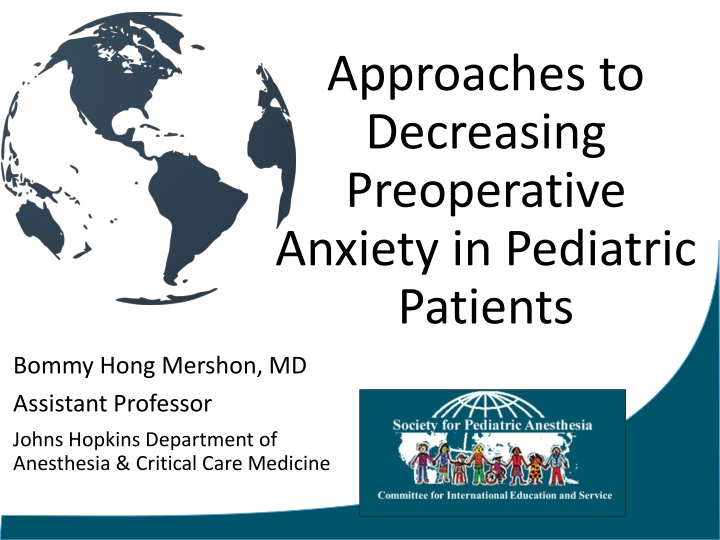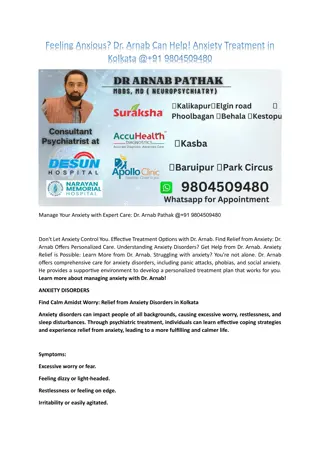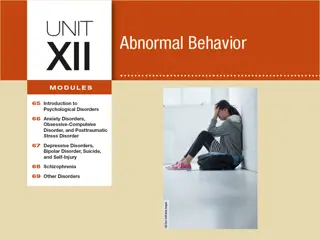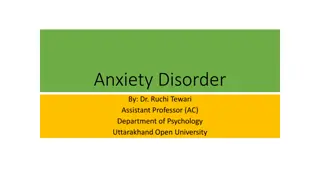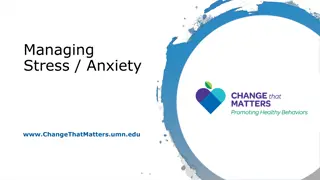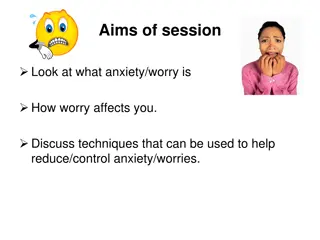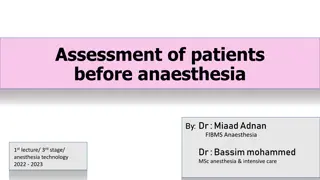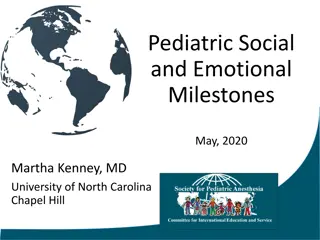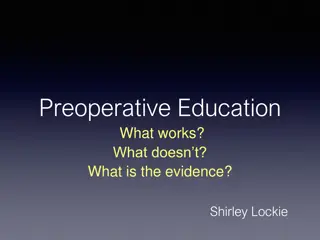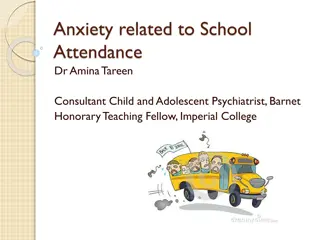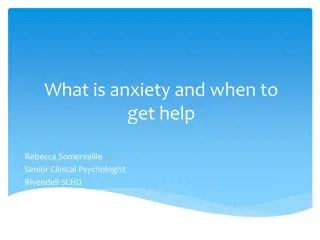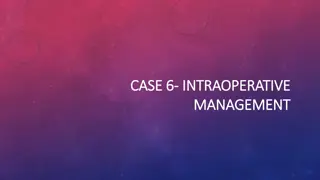Pediatric Strategies to Reduce Preoperative Anxiety Impact
Pediatric preoperative anxiety can lead to negative behavioral changes post-hospitalization and adverse outcomes during anesthesia. Identifying risk factors and implementing non-pharmacologic and pharmacologic interventions can help alleviate anxiety and improve overall surgical experience for children.
Download Presentation

Please find below an Image/Link to download the presentation.
The content on the website is provided AS IS for your information and personal use only. It may not be sold, licensed, or shared on other websites without obtaining consent from the author.If you encounter any issues during the download, it is possible that the publisher has removed the file from their server.
You are allowed to download the files provided on this website for personal or commercial use, subject to the condition that they are used lawfully. All files are the property of their respective owners.
The content on the website is provided AS IS for your information and personal use only. It may not be sold, licensed, or shared on other websites without obtaining consent from the author.
E N D
Presentation Transcript
Approaches to Decreasing Preoperative Anxiety in Pediatric Patients Bommy Hong Mershon, MD Assistant Professor Johns Hopkins Department of Anesthesia & Critical Care Medicine
Disclosures No relevant financial relationships
Learning Objectives: Describe the effects of preoperative anxiety on children Assess the risk factors for developing preoperative anxiety in children Summarize the effects of parental presence during the induction of anesthesia on children Identify other non-pharmacologic approaches to decrease anxiety in children Review pharmacologic premedication options and dosing in children
Effects of Preoperative Anxiety Negative Post Hospitalization Behavior Changes (PHBC): Nightmares/nighttime crying Separation anxiety Eating disorders Enuresis Temper tantrums Increased stress
Duration of Negative PHBC Occurs in up to 88% of children Usually lasts less than 4 weeks 30% to 50% at 2 weeks postop1,2 9% to 32% at 4 weeks postop3,4 20% exhibit PHBC at 6 months postop PHBC can last up to 12 months in 5 - 10% of children
Effects of Preoperative Anxiety Adverse post operative outcomes with future anesthetics Increased postoperative pain Increased analgesic requirements Prolonged recovery and hospital stay
Risk Factors for Negative PHBC After Surgery At 2 weeks post surgery:1 - Mother s anxiety - Child s anxiety At 6 months post surgery:1 - Mother s anxiety
Risk Factors of Negative PHBC Major risk factors: Underlying anxiety in child or parent Previous bad hospital experience Emergence delirium Preschool age Longer hospital stay
Risk Factors of Negative PHBC Additional risk factors: Post op pain on day of surgery predictive of PHBC up to 4 weeks later3 2 or more older siblings Higher level of parental education Having discussion with anesthesiologist preoperatively
Negative PHBC Incidence varies due to Cultural differences Institutional differences Study design Differences in how Post Hospitalization Behavior Questionnaire (PHBQ) is used in studies
Post Hospitalization Behavior Questionnaire (PHBQ) The most commonly used measurement tool Developed in 1960s by Vernon et al5 27 behavior items rated by parents
Questions from the Updated PHBQ for Ambulatory Surgery6 Does your child need a pacifier? Does your child seem to be afraid of leaving the house with you? Does your child seem uninterested in what goes around him/her? Does your child bite his/her fingernails? Does your child seem to avoid or be afraid of new things? Does your child follow you everywhere around the house?
Reasons for Parental Presence at Induction of Anesthesia (PPIA) Primary goal is to decrease anxiety Approximately 50% of children show significant anxiety during induction Factors contributing to anxiety in children - Unfamiliar surroundings - Separation from parents - Fear of needles - Parental anxiety
Does PPIA help? It depends! Level of parental anxiety significant predictor of child anxiety7,8 Maternal anxiety usually higher than paternal anxiety Greatest moment of stress during induction for parent (56%): Loss of consciousness of child 97% parent satisfaction and feeling useful during induction
Does PPIA Help Parents? It depends! Published systematic review9 showed that parental presence during induction does not decrease parental anxiety compared to: No parental presence Midazolam Parental presence + midazolam
Does PPIA Help Children? Published systematic review9 showed that parental presence during induction does not decrease child s anxiety compared to: No parental presence Midazolam Parental presence + midazolam Parental presence + video game
Does PPIA Help? It depends on the parents, the child, and the study Parental presence alone does not alleviate patients or parents anxiety 9 Midazolam or distraction techniques can be suitable substitutes PPIA may reduce preoperative state anxiety of pediatric patients and improve quality of anesthesia induction based on ICC scores and higher parental satisfaction, but it does not impact parental anxiety10
PPIA Biggest factor is the parent and child dynamics Depends on parental advocacy Preference of anesthesiologist Location of procedure/surgery Type of surgery Have an assigned person to escort parent(s) out
Decreasing Preoperative Anxiety: ADVANCE Program11 Randomized, controlled trial of family-centered preop prep program ADVANCE vs. standard of care, midazolam, parental presence Anxiety reduction, Distraction, Video modeling, Adding parents, No excessive reassurance, Coaching of parents, Exposure Certain special populations benefit
Preoperative preparation programs ADVANCE11: - Less anxiety, less emergence delirium, less analgesic requirements, faster discharge vs. only PPIA (parental presence during induction of anesthesia) - This is time consuming (starts 5 - 7 days before surger) and requires significant resources PPIA Preparation study12 - 5-minute video for parents vs. standard PPIA - Shown the day of the child s procedure - Video for parents did not show any reduction in child s anxiety, but parents were more satisfied because they knew what to expect
Non-pharmacologic measures: Distraction Techniques Clowns: conflicting viewpoints - Perceived delay in induction time13 - Too many people during induction13 - Interference with induction process13 - In the clown group, maternal state anxiety significantly decreased and the tendency to somatization did not increase14 - After clown intervention, older children s mothers significantly reduced the level of perceived stress14 Music - Cochrane reviews concluded that music interventions have beneficial effect on preoperative anxiety15 - May provide viable alternative to sedatives or anti-anxiety drugs
Non-pharmacologic Measures: Distraction Techniques Video game6s or watching videos RCT16 comparing PPIA vs Video vs (PPIA + Video) in 117 children 2-7 years old All 3 techniques had similar effects on preop anxiety and postoperative behavioral outcomes RCT17 comparing Midazolam vs Video vs (Midazolam + Video) in 135 children 2-12 years old All 3 techniques had similar effects on preop anxiety
Pharmacologic Premedications Midazolam: Most commonly used premedication in children Produces anterograde amnesia Effective in reducing anxiety for separation from parents and during induction of anesthesia Can by given oral, rectal, intranasal, IV, or IM Negative side effects: restlessness, paradoxical reactions, postop behavioral changes, and cognitive impairment
Midazolam (continued) Oral: most common route - Bitter taste - Bioavailability is approximately 36% (9 - 71%) - Dose: 0.25 - 1 mg/kg (20 mg max) - Onset: 10 - 15 min - Peak effect: 20 - 30 min Rectal dosing same as oral Intranasal - Very unpleasant burning sensation - Dose: 0.2 - 0.5mg/kg - Onset: 10 - 20min IV - Dose: 0.05 - 0.5 mg/kg - Onset: 2 - 30 min - Duration of effect: 45 60 min
Pharmacologic Premedications Diazepam: Slower onset and prolonged half life compared to midazolam Oral/rectal dosing 0.2 - 0.3 mg/kg with peak plasma levels in 60 - 90 minutes IV/IM dosing 0.04 - 0.2 mg/kg
Pharmacologic Premedications Ketamine Oral dosing 3 8 mg/kg IM dosing 4 5 mg/kg - Effective sedation in about 5 minutes - 45 minutes duration of action Can combine 2-3 mg/kg + midazolam 0.1mg/kg IV dosing 1 2 mg/kg Side effects: excessive salivation, nausea/vomiting, nystagmus, and hallucinations
Pharmacologic Premedications Clonidine: Alpha 2 adrenergic agonist Oral dose: 2-4 mcg/kg for sedation/anxiolysis Causes sedation like normal sleepiness but can awaken No amnestic effect Prolonged onset of action (> 90 min) Frequent need for supplemental oxygen
Pharmacologic Premedication Dexmedetomidine: Highly selective alpha 2 adrenergic agonist Intranasal/sublingual/buccal: 1 to 2 mcg/kg IV Loading dose: 0.5 - 2 mcg/kg over 5 - 15 min, then infusion 0.2 - 0.7 mcg/kg/hr IM: 2.5 mcg/kg Oral: 3 - 4 mcg/kg but low bioavailability
Pharmacologic Premedication Fentanyl Available routes: oral, intranasal, IV, or IM Oral transmucosal (lollipop form) Not as effective for anxiolysis Can cause nausea/vomiting
Pearls & Practical Advice Be creative and flexible with induction techniques Play music or videos going to and in the OR Tell stories Make breathing into the mask into a game If the child is afraid of the mask, just use your hands to hold the end of the circuit to form a cup around the child s mouth and nose Induce without monitors*
Pearls & Practical Advice: Vital Capacity Breath Technique For kids who can follow directions! Able to take vital capacity breaths Prime circuit!
Pearls & Practical advice Be mindful of the family dynamics and parental anxiety in preop Think about the age of the child Think about premedication Think about negotiating IV placement in older children
Pearls & Practical advice Engage child life specialists (if available) early Engage preop nurses - They can be instrumental in prepping families well - Educate them on when to alert you if a child will need a premed
References: 1. Kain ZN, Mayes LC, O Connor TZ, Cichetti DV. Preoperative Anxiety in Children: Predictors and Outcomes. Arch Pediatr Adolesc Med. 1996;150:1238-1245. Fortier MA, Kain ZN. Treating perioperative anxiety and pain in children: a tailored and innovative approach. Paediatr Anaesth 2015;25:27-35. Kotiniemi LH, Ryhanen PT, Moilanen IK. Behavioural changes in children following day-case surgery: a 4-week follow-up of 551 children. Anaesthesia 1997;52:970-6. Power NM, Howard RF, Wade AM, et al. Pain and behavior changes in children following surgery. Arch Dis Child 2012;97:879-84. Vernon DT, Schulman JL, Foley JM. Changes in children s behavior after hospitalization. Some dimensions of response and their correlates. Am J Dis Child 1966;111:581-93. Jenkins BN, Kain ZN, Kaplan SH, et al. Revisiting a measure of child postoperative recovery: development of the Post Hospitalization Behavior Questionnaire for Ambulatory Surgery. Paediatr Anaesth. 2015;25(7):738-745. 2. 3. 4. 5. 6.
References: 7. Cameron JA, Bond MJ, Pointer SC. Reducing the anxiety of children undergoing surgery: parental presence during anaesthetic induction. J Paediatr Child Health. 1996;32(1):51-56. Messeri A, Caprilli S, Busoni P. Anaesthesia induction in children: a psychological evaluation of the efficiency of parents' presence. Paediatr Anaesth. 2004;14(7):551-556. Chundamala J, Wright JG, Kemp SM. An evidence-based review of parental presence during anesthesia induction and parent/child anxiety. Can J Anesth. 2009(56):57-70. 10. Sadeghi, A. Khaleghnejad Tabaria A, Mahdavi A, Salarain S, Razavi SS. Impact of parental presence during induction of anesthesia on anxiety level among patients and their parents: a randomized clinical trial. Neuropsychiatr Dis Treat. 2017;12:3237-3241. 11. Kain ZN, Caldwell-Andrews AA, Mayes LC, et al. Family-centered preparation for surgery improves perioperative outcomes in children: a randomized controlled trial. Anesthesiology 2007;106:65-74. 12. Bailey KM, Bird SJ, McGrath PJ, Chorney JE. Preparing parents to be present for their child s anesthesia induction: A randomized controlled trial. Anesthesia-Analgesia 2015;121:1001-10. 8. 9.
References: 13. Vagnoli L, Caprilli S, Robiglio A, Messeri A. Clown Doctors as a Treatment for Preoperative Anxiety in Children: A Randomized, Prospective Study. Pediatrics 2005;116 (4):e563-e567. 14. Agostini F, Monti F, Neri E, Dellabartola S, de Pascalis L, Bozicevic L. Parental anxiety and stress before pediatric anesthesia: a pilot study on the effectiveness of preoperative clown intervention. J Health Psychol. 2014;19(5):587-601. 15. Bradt J, Dileo C, Shim M. Music interventions for preoperative. Cochrane Database of Systematic Reviews 2013, Issue 6. Art. No.: CD006908. 16. Kim H, Jung SM, Yu H, Park SJ. Video Distraction and Parental Presence for the Management of Preoperative Anxiety and Postoperative Behavioral Disturbance in Children: A Randomize Controlled Trial. Anesthesia-Analgesia 2015;121(3):778-784. 17. Sola C, Lefauconnier A, Bringuier S, Raux O, Capdevila X, Dadure C. Childhood preoperative anxiolysis: Is sedation and distraction better than either alone? A prospective randomized study. Paediatr Anaesth. 2017;27(8):827-834.
